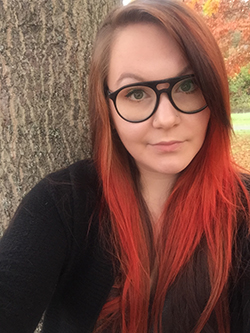A Reflective Space: Kyra Kristmanson in Conversation with Alycia Pirmohamed

Alycia Pirmohamed, whose poem "Held In" appeared in The Malahat Review's Spring 2019 Issue #206, discusses themes of water, Asian American women writers, and who and what inspires her in her Q&A with Malahat Review editorial assistant Kyra Kristmanson.
Alycia Pirmohamed is a Canadian-born poet living in Scotland. She received an M.F.A. from the University of Oregon, and is a current Ph.D. student at the University of Edinburgh, where she is studying poetry written by second-generation immigrants. Her forthcoming chapbook, Faces that Fled the Wind, was selected by Camille Rankine for the 2018 BOAAT Press Chapbook Prize.
Before we talk about “Held In” I really want to talk about you. You’re a Canadian-born poet living in Scotland, working on your Ph.D., focusing on poetry written by second-generation immigrants. That’s just absolutely inspiring to me. Can you tell me how you first discovered poetry, and why you chose to pursue the medium—not just creatively but academically, as well?
My interest in writing began with prose, which led me to a few online writing communities when I was a teenager. To be honest, it was these online networks that first introduced me to what poetry could be—I was reading drafts by young writers, poetry that broke all the rules I thought existed. I wouldn’t have taken my first poetry workshop in my undergrad without falling in love with the genre through this medium first. I was a biology major; it could have fallen off my radar completely.
After that, it was mostly a whirlwind of wonderful professors and peers. I didn’t know MFAs existed. Not until an incredibly transformative workshop toward the end of my degree. A very dear mentor of mine encouraged my work by inspiring me to write about my stories, my history, my cultural background. I had internalised a lot of racism, a lot of self-hatred, but poetry gave me one path to self-acceptance. This, combined with a deep love for language, a fascination with imagery, is why I chose to pursue it further.
I think it’s because of the intersections of these histories and experiences that I also frame a lot of my current non-creative work on BIPOC voices. My critical thesis on second-generation immigrant poetry is one way I’m working toward that, and again, something I wouldn’t have been able to pursue without my MFA advisor. I’ve been so lucky to have had exceptional mentors throughout my life, both in academic and non-academic spaces. I’ve continued in academia for a few reasons: I think the topic I’m researching is incredibly interesting, and more should be written about it! And also, I would absolutely love to teach and mentor young writers in the future.
You’re editing an anthology due to be published in 2020: They Rise Like A Wave: An Anthology of Asian American Women Poets. I have to say, that title is fantastic, and I’m dying to read it! Not only that, but I think it’s a collection that North America desperately needs right now. How did this project come to be?
It never really clicked that most of what I was recommended to read was written by men until I took a women’s studies course in my undergrad. I spent that semester reading a syllabus of entirely women writers—stories centered on women characters and told from their perspectives. Two novels I read in that course have stayed with me all this time, and I continuously return to them: Tamarind Mem. by Anita Rau Badami and The End of East by Jen Sookfong Lee. Both grappled with intergenerational trauma, womanhood, and cultural dissonance within the context of Asian American diaspora. It was astonishing to see aspects of my life so nakedly and beautifully crafted in these works: not a character completely dissociated from myself, not stereotyped Asian presences at the periphery, but Asian American women at the forefront.
Some of my greatest influences and favourite writers are Asian American women. I find myself lucky now, to be reading and writing at a time where online publishing and social media have made these voices more accessible. Having spent so much time in academia, so entrenched in a narrow, colonial canon, this change is liberating. I was approached by the Blue Oak Press team to weave together and direct the course for this anthology with my co-editor, Christine Kitano, and I enthusiastically accepted. We’re hoping for They Rise Like A Wave to be a chorus against the discrimination and misrepresentation still rampant in North America—an array of poems that challenge the expected and stereotypical narratives of Asian American women. And most of all, we hope this anthology will be a celebration of these magnificent writers!
Diving into “Held In,” the poem winds through themes of identity, positionality, and breaking free. I found an ethereal sort of presence to the narrator at first, but there was a turning point in the line “and I am trying not to cross out myself.” Then, the narrator transitions into a delicate metamorphosis, and obtains freedom without disconnection from their previous self. That moment resonates with self-discovery and acceptance. Were you inspired by something in particular or did the poem materialize when you sat down to write?
I wrote this poem at a time of major transition in my life—and although there are symbols and moments within the poem that lean toward specific people and relationships, it ultimately holds together on the idea of change and growth of self. It was also initially prompted by place. I moved to Oregon for my MFA, which meant moving away from the communities and places I loved for the possibility of something new. My future was unfurling to look like something completely different than I expected. “Held In” grapples with that feeling: how does a landscape, an environment, change a body? How much is altered, and what essential aspects of you are kept in place? What do we harbour and what do we make peace with letting go of, given time and distance?
I really appreciate your comment about self-discovery and acceptance. A lot of my anxieties and questions, which manifest in my poetry, have to do with understanding my place in the world and where I belong. Over and over again, I find myself trying to mould who I am to fit in. And continuously, I have to remind myself not to negotiate my identity, not to cross it out or let it disappear. “Held In” comes with a certain kind of agency that way, I think.
The narrator addresses the reader directly, describing an erasure of “all the words still shaped like you.” There is an ambiguity in the words the narrator identifies: “canyon, pigeons, throat, skin, peaches, denim.” Is the poem addressed to a certain individual, to a stranger, or to a collective? Or is it addressing an idea rather than a person?
Although the poem initially began as an intimate address, a reflection on a relationship, I’d say it exists now in a more imaginative realm. Although the symbols, or the words, explicitly outlined in the poem first came from memories and experiences with a specific person, they morphed from addressing solely a specific ‘you.’ I like to think of them as more flexible—markers of moments in time, of particular places. Though the ‘you’ could absolutely be a collective in some readings, depending on the perspective, I tend to read it as either a specific you, a conflated you/I, or the idea of place. It represents the things or people that become a part of someone’s history when transitioning to a new space, physically and/or emotionally.
Water is a recurring image throughout the poem. There’s a sense of fluidity as much as a sense of the narrator feeling bogged down. Can you speak to this juxtaposed duality a little?
Rivers and water are reoccurring in my poetry. Partially, I think, because they’re so rich with imagistic and metaphorical potential. Maybe I’m also drawn to them because they’re a reflective space: a sort of in between, a kind of stasis. When a poem is so prompted by things changing, by a transformation of some kind, the act of floating, of being suspended, is almost an anchor. I think in “Held In,” there is also the sense of letting go—how you might feel lighter afterward, and how, eventually, no longer being bogged down is what keeps you from sinking, so that you might eventually move forward.
Thank you again for this really insightful look into my work. I’m so glad you brought this up, because I’ve been playing around with the water motif in my recent work, especially by exploring the idea of crossing water, and how it might create connections and separations. Safia Elhillo has this gorgeous line, “i am from / anywhere halved by water” (still life with the accent), which I think about a lot.
Your poetry has won several prizes including the 2019 92Y/Discovery Poetry Contest and the 2018 Ploughshares’ Emerging Writer’s Contest. Your work has been published in a plethora of literary journals, and your upcoming chapbook Faces that Fled the Wind was chosen for the 2019 BOAAT Press Chapbook Prize. Who are some poets who’ve inspired you, and what is the best piece of writing advice you’ve ever received?
I have had such a surreal year! I honestly can’t even put into words how grateful I am to all the people who saw something in my work. I’m still in shock. I hope to be able to pay it forward one day.
The list of poets who have inspired me is truly endless! Reading Li-Young Lee opened a world of possibility. Nazim Hikmet’s “Things I Didn’t Know I Loved” was probably the first poem I ever really loved. Derek Walcott, Brigit Pegeen Kelly, and Aga Shahid Ali remain favourites. More recently, I’ve been inspired by Safia Elhillo, Shivanee Ramlochan, Gwen Benaway, Doyali Islam, Hala Alyan, and so many more! Including many, many wonderful friends.
I’ve received a lot of great writing advice, but one thing that has stayed with me is Garrett Hongo’s advice to follow a poem’s metaphor(s), which is particularly helpful for endings. I suppose this means I’m more mindful when exiting a poem’s metaphorical/imagistic vocabulary now—that isn’t to say I always stay within it, but I do try to be more deliberate with my surprises and turns.

Kyra Kristmanson
* * * * * * * *









